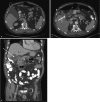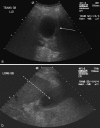Percutaneous Cholecystostomy: Evidence-Based Current Clinical Practice
- PMID: 27904248
- PMCID: PMC5088094
- DOI: 10.1055/s-0036-1592326
Percutaneous Cholecystostomy: Evidence-Based Current Clinical Practice
Abstract
The role of percutaneous cholecystostomy (PC) in the management of acute cholecystitis and cholangitis is outlined in the revised 2013 Tokyo Guidelines. These two emergencies constitute the vast majority of PC performed today for therapeutic purposes, and research has repeatedly shown the utility of PC in these conditions. PC is typically employed in the management of critically ill patients who are not surgical candidates. Indications and contraindications to PC are reviewed. Additional innovative applications of PC have been developed since it was first described in 1980. These include biliary drainage, dilation of biliary strictures, and stenting of the biliary tree including the common bile duct. Special consideration must be given to the patient selection criteria when deciding who can benefit from PC. Patient comorbidities can also influence the PC technique employed. Both transhepatic and transperitoneal approaches have distinct advantages and disadvantages. The technical success rate for PC is 95 to 100% and the complication rate is extremely low. Most complications are minor.
Keywords: cholecystitis; gallbladder; gallstones; interventional radiology; percutaneous cholecystostomy.
Figures



References
-
- Radder R W. Ultrasonically guided percutaneous catheter drainage for gallbladder empyema. Diagn Imaging. 1980;49(6):330–333. - PubMed
-
- Saad W E, Wallace M J, Wojak J C, Kundu S, Cardella J F. Quality improvement guidelines for percutaneous transhepatic cholangiography, biliary drainage, and percutaneous cholecystostomy. J Vasc Interv Radiol. 2010;21(6):789–795. - PubMed
-
- Strasberg S M. Clinical practice. Acute calculous cholecystitis. N Engl J Med. 2008;358(26):2804–2811. - PubMed
-
- Huffman J L, Schenker S. Acute acalculous cholecystitis: a review. Clin Gastroenterol Hepatol. 2010;8(1):15–22. - PubMed
Publication types
LinkOut - more resources
Full Text Sources
Other Literature Sources
Medical

